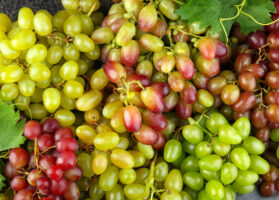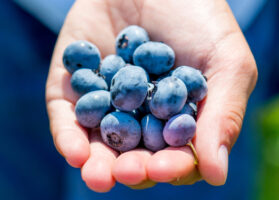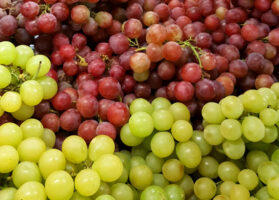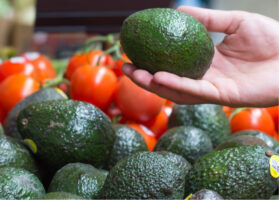Grapes remain popular, especially in new varieties, and often in smaller packages
Overview of grapes from California in the U.S. market, complemented by charts from Agronometrics. Original published on September 14, 2022.
As an easily accessible fruit that makes for a simple and quick snack or side, grapes are highly popular with many American consumers, especially in the fall around harvest-time. But the grape industry is adapting to demands from retailers and consumers, and releasing more varieties of these small fruits — a move that’s welcomed by some, but not so much by others.
According to the California Table Grape Commission in Fresno, Calif., the top 15 varieties of grapes account for 76% of the volume, and of these, the top five volume varieties are Autumn King, Scarlet Royal, Sheegene-20, Flame Seedless and Sheegene-21.
California is a hotbed of grape-growing, and more than 99% of table grapes grown commercially in the U.S. come from that state. The crop was valued at $2.14 billion in 2021, and the grapes come in three colors — green, red and black — and 81 varieties.
“We are like Baskin-Robbins and have to have all the flavors,” says Pete Hronis, senior vice president of sales and marketing for Hronis, Inc. in Delano, Calif. “That’s what retailers are demanding. And new varieties have better taste, appearance and shelf life. There are new varieties coming out every year, so my plan is to stay very diversified with a little bit of a lot of varieties and not a lot of one.” What consumers are looking for with the different types, he adds, is first, appearance, followed by taste, “which means they’ll come back and purchase more.”
Hronis grows 17 varieties, with green grapes winning with consumers, though red and green are pretty equally loved, Hronis points out, and black grapes stay steady at about 10% of sales/production.
Source: USDA Market News via Agronometrics.
(Agronometrics users can view this chart with live updates here)
However, there are challenges to offering new varieties, says John Pandol, director of special products for Pandol Bros., also in Delano, who offers varieties including Cotton Candy and Sweet Globe. “One of our big challenges is the very rapid introduction to new varieties, and varietal obsolescence is a big problem. We need four or five years for a crop, and we need six years to recoup. And if it’s obsolete in 10 years, I’ve not had a chance to get my money back.” Conversely, he says, in the past, when he planted a variety, it was agronomically and economically viable for 20 years. However, he said, with many of the newer varieties, yields do go up.
Top Brass adds new varieties of grapes every year, says Brett Dixon, president of the Bakersfield, Calif.-based company. “This season, our Candy varieties and our green varieties have proven to be most popular and in the highest demand.”
MARKET GENERALITIES
At press time, the grape harvest was in full swing and going well in California. “The projection is for a crop comparable in size to last season,” says Kathleen Nave, president and CEO of the California Table Grape Commission.
And while “the drought affects every aspect of life in California,” she says that, overall, the weather has been good for growing grapes.
California table grapes are primarily sold in the U.S., though the industry does export around 37% to more than 50 states, says Knave. For Hronis, that switches to 90% of grapes sold within the U.S., mostly the northeast and southeast, and most exports are to the Pacific Rim.
Pandol Bros. sells 70% of its grapes domestically, 10% go to Canada, and 20% are sold internationally, but exports to Asia, Oceana, and Latin America have been less the past few season, Pandol says. “The unreliability of transit times, weaker economic activity in many countries and the threat of additional COVID-related measures keep both exporters and importers more conservative,” he adds.
FACING CHALLENGES
The top concerns for table grape growers “revolve around the high costs of production; access to water and labor; packaging and shipping costs; transport availability and costs; and import competition,” says Nave.
However, Pandol Farms doesn’t have labor problems because it offers steady work, says Pandol. “A bigger problem is the new [California] overtime rules, which were originally 60 hours, then 50 and now 40, which is a bit of an injustice because you’re restricting these people.”
Hronis has a citrus program, so can employ staff year-round, even when the grapes don’t need tending. “We don’t have seasonal programs; our people live here and their kids go to school here,” Hronis points out. And that’s helpful, he says, because it means there’s no annual retraining required.
Water, however, is a challenge. “We have two sources of water at all of our fields — surface water and well water — so we’re in a good position, but water has been tight for a number of years,” he said. And that’s not all. “There’s always worry in the farming business — water, weather, market — and that’s a normal course of my day.”
Top Brass’ Dixon says he sees a large percentage of the industry farming on a budget and hanging huge crops, which does not deliver the best product, he said. “It just floods the market with less-desirable grapes and typically with less shelf life. You cannot farm properly on a budget when each year is so drastically different from the previous years. It takes time, money and experience to grow grapes that our customers know they can purchase with confidence and without quality or sizing issues that will last on their shelves.”
However, Dixon does believe that, in the next few years, there will be fewer corporate investments in the parts of the industry that have oversupplied mediocre fruit.
“As time moves along, we anticipate this will create more opportunity for the large family farms who are hands-on daily and bring the overall production of better fruit to the market,” he said.
PACKAGING CHANGES
Sustainability has become an important factor for all businesses, but so far, it’s not having much of an impact on the grape business.
Over the past two years, Pandol has seen packaging shift from 13% clamshells/87% bags to 22% clamshells/78% bags.
“This bump surprised us,” Pandol said. He attributes this to several reasons, but primarily, that clamshells are easier to stock and maintain in stores, and perform better than bags in e-commerce.
What he does expect to see are clamshell labels that wash off so the plastic can be recycled. “But for the near term,” he adds, “clear, film bags are the flexible packaging majority, complemented by plastic clamshells where ridged packaging is called for.”
Pandol is also offering smaller packages because of the sticker shock of large bags. One chain that used 3 pounds for its value pack now has 2-pound bags because it wants to get a certain ring. “Even though it’s the same price per pound, consumers buy more 2-pound bags,” Pandol said.
Hronis has also seen an increase in clamshells, especially multicolor clamshells containing two or three colors of grapes, “which is a great idea to give you a little bit of three things, and it’s also perfect if you’re going to someone’s home.”
The company sells 2-pound and 3-pound bags, “and I haven’t seen a drastic change, and we sell quite a bit of those.” But Hronis admits that, “because of inflation, stores are requiring smaller packaging, so the price is attractive, even though they contain less weight.”
WORKING WITH RETAILERS
Hronis works with retailers to give them whatever helps sell grapes, including demos and point-of-sale materials. “But the bottom line is, good product at a good price is what works,” he said.
Grapes perform well year-round at Food Lion’s more than 1,100 stores in eastern states. And though seedless varieties dominate, “over the past three years, we’ve seen resurgence of consumption of seeded grapes,” said Nicole Hulstein, the company’s fruit category manager.
And when it comes to color, Hulstein sells about equal amounts of red and green grapes, and she’s seeing a strong demand for both organic and conventional versions of the fruits.
Hulstein works closely with her suppliers to ensure grapes arrive and are held at optimal temperatures. Some of her grapes come from East Coast suppliers, and she likes to tell their stories in the produce department.
Grapes in random-weight bags sell best for this chain, and Hulstein like to merchandise them with berries. However, in the fall, she pulls out the grapes and features them on a front table in the produce department, and always sees a sales spike.
“This is the time of year when I push grapes,” she said. “It’s important to bring the seasons to life by putting appropriate produce front and center.”
The News in Charts is a collection of stories from the industry complemented by charts from Agronometrics to help better tell their story.
Access the original article with this (Link)






